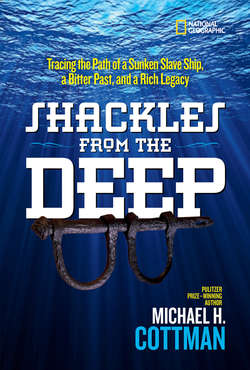Читать книгу Shackles From the Deep: Tracing the Path of a Sunken Slave Ship, a Bitter Past, and a Rich Legacy - Michael Cottman - Страница 15
CHAPTER 4
Оглавление
Wisdom does not come overnight. ∼ Somali proverb
LATE ONE
AFTERNOON in July 1983, David Moore was aboard the Trident, peeling off his sea-worn wet suit.
For days, David had worked with other divers to survey strategic sections underwater looking for one important yet elusive piece of evidence: the ship’s bronze sailing bell. He assumed that like most ships there would be a bell that would bear the name of the vessel—a vital clue that would help them unravel the mystery of this shadowy shipwreck. They needed this piece to start to put together the puzzle and confirm their theories about the ship’s origins.
David was tired and a bit anxious. But then, as he emerged from the water, he heard one of his crewmates yell: “Hey, you’re not going to believe this. I think we found something big!”
David rushed to the front of the boat, grabbed his dive gear, and stepped into the Gulf of Mexico. The other divers quickly followed.
On the seafloor, one crewmate led the group to an unexplored section of New Ground Reef where, buried in the sand and crusted over, there was a large object. David smiled through his dive mask.
It took a team of three men to hoist the heavy bell onto the Trident and place it in the middle of the deck. After several minutes of staring at the bell in disbelief, everyone started laughing and clapping and high-fiving and reveling in the most significant find from the English Wreck.
The bell was 13 inches high, and two-thirds of it was covered in limestone, which had helped protect it from the salt water.
But David, having studied the history of similar ships, recognized this as a specific kind of bell, a watch bell, which sounds every half hour to signal crew changes aboard a ship. Watches on deck are changed every eight bells.
David reached for a screwdriver (hey, not all archaeology is about delicate brushes and picks) and began to chip away at the thick coating on the bell.
As he scraped the hard, green layers away, a number slowly appeared. A “9.” During the next few minutes, another “9” appeared, and then a “6,” until a full date was showing on the bell: “1699.” Everyone crowded around as David turned the bell around and started scraping the other side.
Slowly, one by one, bold letters began to appear until the crew was able to read the words that were inscribed on the bell:
